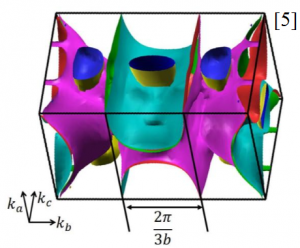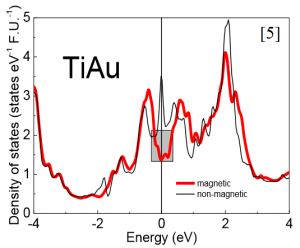Supervisor: Dr Monika Gamza

Our current understanding of magnetism is based on two opposite perspectives. In the first one, the so-called local moment picture, long-ranged magnetic order develops owing to exchange interactions between local moments carried by individual atoms. By contrast, in the alternative itinerant view, an unpolarized conduction electron sea exhibits a correlation driven Stoner-type magnetic instability [1] which leads to a local imbalance of up- and down-spins. While the local moment magnetism was readily explained early on within a Heisenberg model [2] using a Weiss molecular field approximation, the itinerant moment behaviour is still only poorly understood and a unified theory of magnetism that could encompass both these extreme scenarios remains elusive. The main limitation is a very small number of known examples of materials that are close to the itinerant limit. So far only two ferromagnets have been discovered that are made of nonmagnetic constituents, Sc3In [3] and ZrZn2 [4].
Recently, a new method of designing materials called theory-assisted synthesis has been developed. Application of this novel technique led us to the discovery of the first itinerant antiferromagnet with no magnetic constituents, TiAu [5].
The Project
The proposed PhD project will focus on searching for consecutive systems built of nonmagnetic elements only in which strong spin fluctuations may lead to itinerant spin-density-wave-type magnetic order at low temperatures. The project will start with performing a series of density functional theory based electronic band structure calculations aiming at choosing candidate compounds for experimental investigations.

Attempts to synthesize crystals of such materials will be carried as the next step. Structural and compositional characterization of grown phases will be carried at UCLAN (X-ray diffraction, scanning electron microscopy with energy-dispersive X-ray microanalysis) and will be followed by physical properties measurements (ac magnetic susceptibility, dc magnetization, electrical resistivity and specific heat) at Royal Holloway, University of London, using a standard Physical Property Measurement System (PPMS, Quantum Design) and an Adiabatic Demagnetization Refrigerator system at temperatures between 0.2K and 400K and in magnetic fields of up to 9 Tesla owing to a collaboration with the group of Dr Philipp Niklowitz. There will be also a possibility of performing high pressure electrical resistivity and magnetic susceptibility measurements using piston cylinder cells and Bridgman-type high pressure cells available at Royal Holloway, University of London. Where appropriate, additional experiments will be conducted using advanced user facilities in the UK such as Diamond Light Source and ISIS pulsed neutron and muon source at the Rutherford Appleton Laboratory as well as Leeds EPSRC Nanoscience and Nanotechnology Research Equipment Facility.
The project is fully funded for UK and EU students holding or expecting good undergraduate/postgraduate degrees in Physics, Chemistry or related subjects. For details on the project or application procedures please contact Dr Monika Gamza: MGamza@uclan.ac.uk
References
[1] Stoner, E.C. Collective electron ferromagnetism. Proceedings of the Royal Society of London A 165, 372 (1938).
[2] Heisenberg, W., Zeitschrift fur Physik 49, 619 (1928).
[3] Matthias, B.T., Clogston, A.M., Williams, H. J., Corenzwit, E. & Sherwood, R.C., Ferromagnetism in solid solutions of scandium and indium. Physical Review Letters 7, 7 (1961).
[4] Matthias, B.T. & Bozorth, R.M. Ferromagnetism of a zirconium-zinc compound. Physical Review 109, 604 (1958).
[5] Svanidze, E., Wang, J.K., Besara, T., Liu, L., Huang, Q., Siegrist, T., Frandsen, B., Lynn, J.W., Nevidomskyy, A.H., Gamża, M.B., Aronson, M.C., Uemura, Y.J., and Morosan, E., Novel Itinerant Antiferromagnet TiAu, arXiv:1409.0811 (under review in Nature Communications)
